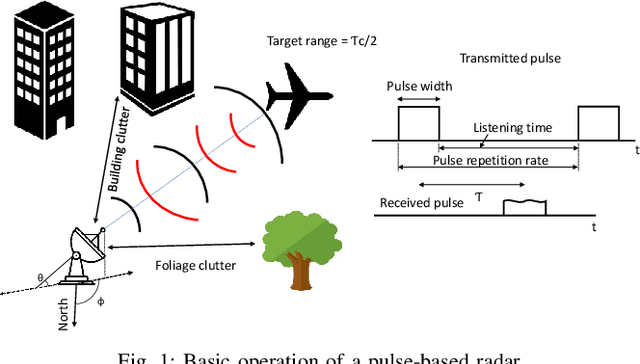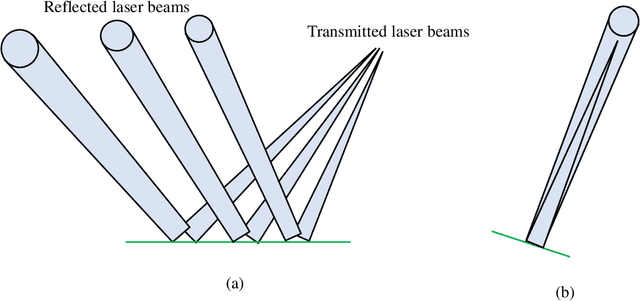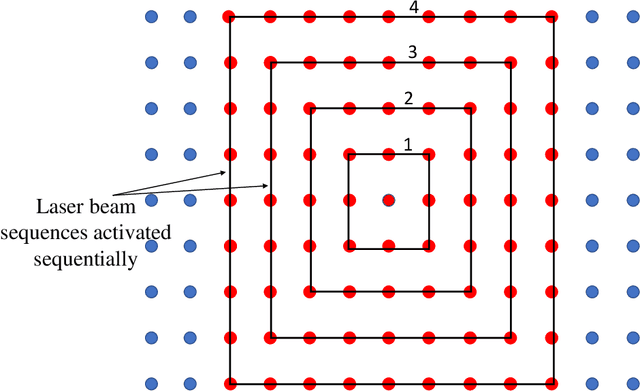Wahab Khawaja
Predicting Lifespan of Ground-to-Air Multipath Components in mmWave UAV Channels
Mar 12, 2025Abstract:In mobile ground-to-air (GA) propagation channels, the birth and death of multipath components (MPCs) are frequently observed, and the wide-sense stationary uncorrelated scattering (WSSUS) assumption does not always hold. Several methods exist for tracking the birth and death of MPCs, however, to the best of knowledge of authors, there is no existing literature that addresses the prediction of the lifespan of the MPCs in nonWSSUS GA propagation channels. In this work, we consider the GA channel as non-WSSUS and individual MPCs across receiver positions are represented as time series based on the Euclidean distance between channel parameters of the MPCs. These time series representations, referred to as path bins, are analyzed using a semi-Markov chain model. The channel parameter variations and dependencies between path bins are used to predict the lifespan of path bins using weighted sum method, machine learning classifiers, and deep neural networks. For comparison, the birth and death of path bins are also modeled using a Poisson distribution and a Markov chain. Simulation results demonstrate that deep neural networks offer highly accurate predictions for the lifespan (including death) of MPC path bins in the considered GA propagation scenario.
* Accepted for Proc. IEEE WCNC Conference 2025, Italy
A Survey on Detection, Classification, and Tracking of Aerial Threats using Radar and Communications Systems
Feb 08, 2024Abstract:The use of unmanned aerial vehicles (UAVs) for a variety of commercial, civilian, and defense applications has increased many folds in recent years. While UAVs are expected to transform future air operations, there are instances where they can be used for malicious purposes. In this context, the detection, classification, and tracking (DCT) of UAVs (DCT-U) for safety and surveillance of national air space is a challenging task when compared to DCT of manned aerial vehicles. In this survey, we discuss the threats and challenges from malicious UAVs and we subsequently study three radio frequency (RF)-based systems for DCT-U. These RF-based systems include radars, communication systems, and RF analyzers. Radar systems are further divided into conventional and modern radar systems, while communication systems can be used for joint communications and sensing (JC&S) in active mode and act as a source of illumination to passive radars for DCT-U. The limitations of the three RF-based systems are also provided. The survey briefly discusses non-RF systems for DCT-U and their limitations. Future directions based on the lessons learned are provided at the end of the survey.
Propagation Measurements and Coverage Analysis for mmWave and Sub-THz Frequency Bands with Transparent Reflectors
Jun 25, 2023Abstract:The emerging 5G and future 6G technologies are envisioned to provide higher bandwidths and coverage using millimeter wave (mmWave) and sub-Terahertz (THz) frequency bands. The growing demand for higher data rates using these bands can be addressed by overcoming high path loss, especially for non-line-of-sight (NLOS) scenarios. In this work, we investigate the use of passive transparent reflectors to improve signal coverage in an NLOS indoor scenario. Measurements are conducted to characterize the maximum reflectivity property of the transparent reflector using channel sounder equipment from NI. Flat and curved reflectors, each with a size of 16 inches by 16 inches, are used to study coverage improvements with different reflector shapes and orientations. The measurement results using passive metallic reflectors are also compared with the ray-tracing-based simulations, to further corroborate our inferences. The analysis reveals that the transparent reflector outperforms the metal reflector and increases the radio propagation coverage in all three frequencies of interest: 28~GHz, 39~GHz, and 120~GHz. Using transparent reflectors, there is an increase in peak received power that is greater than 5~dB for certain scenarios compared to metallic reflectors when used in flat mode, and greater than 3~dB when used in curved (convex) mode.
A Survey on Detection, Tracking, and Classification of Aerial Threats using Radars and Communications Systems
Nov 18, 2022



Abstract:The use of unmanned aerial vehicles (UAVs) for different applications has increased many folds in recent years. The UAVs are expected to change the future air operations. However, there are instances where the UAVs can be used for malicious purposes. The detection, tracking, and classification of UAVs is challenging compared to manned aerial vehicles (MAVs) mainly due to small size, complex shapes, and ability to fly close to the terrain and in autonomous flight patterns in swarms. In this survey, we will discuss current and future aerial threats, and provide an overview of radar systems to counter such threats. We also study the performance parameters of radar systems for the detection, tracking, and classification of UAVs compared to MAVs. In addition to dedicated radar systems, we review the use of joint communication-radar (JCR) systems, as well as passive monitoring of changes in the common communication signals, e.g., FM, LTE, and any transmissions that may radiate from a UAV, for the detection, tracking, and classification of UAVs are provided. Finally, limitations of radar systems and comparison with other techniques that do not rely on radars for detection, tracking, and classification of aerial threats are provided.
Indoor Propagation Measurements with Sekisui Transparent Reflectors at 28/39/120/144 GHz
Mar 15, 2022



Abstract:One of the critical challenges of operating with the terahertz or millimeter-wave wireless networks is the necessity of at least a strong non-line-of-sight (NLoS) reflected path to form a stable link. Recent studies have shown that an economical way of enhancing/improving these NLoS links is by using passive metallic reflectors that provide strong reflections. However, despite its inherent radio advantage, metals can dramatically influence the landscape's appearance - especially the indoor environment. A conceptual view of escaping this is by using transparent reflectors. In this work, for the very first time, we evaluate the wireless propagation characteristics of passive transparent reflectors in an indoor environment at 28 GHz, 39 GHz, 120 GHz, and 144 GHz bands. In particular, we investigate the penetration loss and the reflection characteristics at different frequencies and compare them against the other common indoor materials such as ceiling tile, clear glass, drywall, plywood, and metal. The measurement results suggest that the transparent reflector, apart from an obvious advantage of transparency, has a higher penetration loss than the common indoor materials (excluding metal) and performs similarly to metal in terms of reflection. Our experimental results directly translate to better reflection performance and preserving the radio waves within the environment than common indoor materials, with potential applications in controlled wireless communication.
Doors in the Sky: Detection, Localization and Classification of Aerial Vehicles using Laser Mesh
Nov 14, 2021



Abstract:The stealth technology and unmanned aerial vehicles (UAVs) are expected to dominate current and future aerial warfare. The radar systems at their maximum operating ranges, however, are not always able to detect stealth and small UAVs mainly due to their small radar cross-sections and/or low altitudes. In this paper, a novel technique as an alternative to radar technology is proposed. The proposed approach is based on creating a mesh structure of laser beams initiated from aerial platforms towards the ground. The laser mesh acts as a virtual net in the sky. Any aerial vehicle disrupting the path of the laser beams are detected and subsequently localized and tracked. As an additional feature, steering of the beams can be used for increased coverage and improved localization and classification performance. A database of different types of aerial vehicles is created artificially based on Gaussian distributions. The database is used to develop several machine learning (ML) models using different algorithms to classify a target. Overall, we demonstrated through simulations that our proposed model achieves simultaneous detection, classification, localization, and tracking of a target.
 Add to Chrome
Add to Chrome Add to Firefox
Add to Firefox Add to Edge
Add to Edge